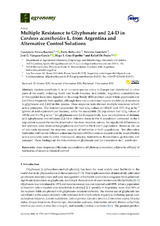Multiple Resistance to Glyphosate and 2,4-D in Carduus acanthoides L. from Argentina and Alternative Control Solutions
Autor
Palma-Bautista, Candelario
Belluccini, Pablo
Gentiletti, Valentin
Vázquez-García, José Guadalupe
Cruz Hipólito, Hugo E.
Prado, Rafael de
Editor
MDPIFecha
2020Materia
Dose-responseShikimate accumulation
Ethylene accumulation
Adjuvants
Efficacy of herbicides
Alternative chemical control
METS:
Mostrar el registro METSPREMIS:
Mostrar el registro PREMISMetadatos
Mostrar el registro completo del ítemResumen
Carduus acanthoides L. is an invasive species native to Europe and distributed in other parts of the world, including North and South America. In Cordoba, Argentina, control failures of this species have been reported in Roundup Ready (RR) soybean crops where glyphosate and 2,4-D have frequently been applied, although there are no confirmed reports worldwide of resistance to glyphosate and 2,4-D in this species. Dose–response tests showed multiple-resistance to both active principles. The resistant population (R) had LD50 values of 1854.27 and 1577.18 g ae ha−1 (grams of acid equivalent per hectare), while the susceptible (S) population had LD50 values of 195.56 and 111.78 g ae ha−1 for glyphosate and 2,4-D, respectively. Low accumulations of shikimic acid (glyphosate) and ethylene (2,4-D) at different doses in the R population compared to the S population support the results observed in the dose–response curves. No significant differences in leaf retention were observed for glyphosate and 2,4-D in the R and S populations. However, the use of adjuvants increased the retention capacity of herbicides in both populations. Ten alternative herbicides with seven different action mechanisms (MOAs) were evaluated and the most effective active principles were dicamba, bromoxynil, atrazine, tembotrione, flazasulfuron, glufosinate, and paraquat. These findings are the first evidence of glyphosate and 2,4 D resistance in C. acanthoides.

